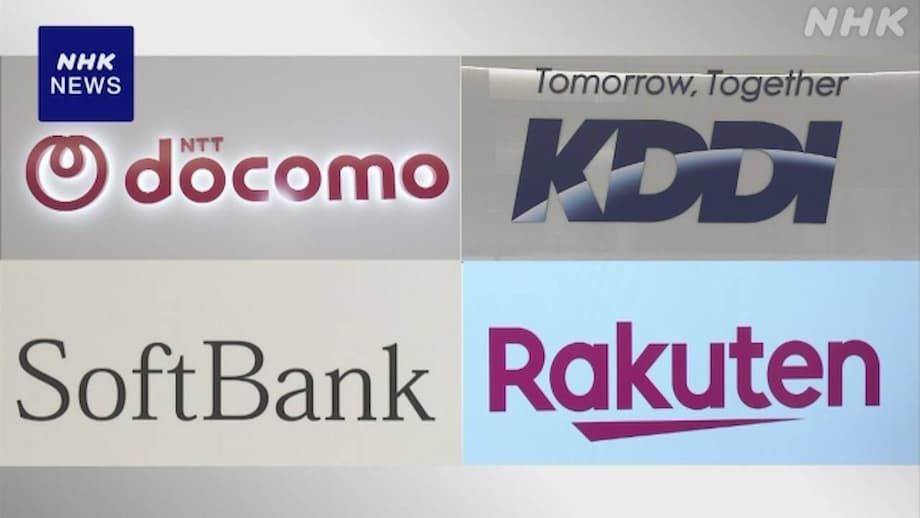Why prices are rising now
Japan’s biggest mobile carriers are lifting monthly plan prices after a long stretch of intense price competition. The trigger is a mix of higher electricity costs, rising network expenses, and the need to fund upgrades as data use keeps climbing. KDDI raised monthly fees for major plans on its au service in August by either 220 or 330 yen, which is about 1.5 or 2.2 dollars, while adding satellite data communication and other functions. NTT Docomo lifted the monthly price of its main plans in June by about 1,100 yen, around 7.4 dollars, and bundled access to a sport streaming service. KDDI plans to increase prices for its UQ Mobile brand in November by 110 or 220 yen, about 0.7 or 1.5 dollars, paired with higher data allowances. SoftBank and Rakuten Mobile say they do not intend to change prices for core plans for now. These developments were reported by NHK, which highlighted how companies are trying to balance price increases with added value to soften the impact on customers. The pattern is familiar across mature telecom markets, where the cost of keeping networks fast, resilient, and secure has gone up even as price pressure remains strong.
Japan’s cost base has shifted in recent years. Electricity prices have been volatile. The weaker yen has raised the cost of imported equipment, from radio units to backhaul gear. Data use is at record levels, which pushes up spending on network capacity and back office systems. Carriers are also preparing for the next wave of connectivity services, including satellite to mobile features, and investing in security and disaster readiness. Fees in Japan have been relatively low compared with peers, particularly after a government push earlier in the decade to encourage cheaper options and new online brands.
That gap with overseas markets is one reason some analysts expect more increases. Yokota Hideaki, vice president of the MM Research Institute, framed the situation bluntly when speaking about Japan’s price levels compared with other nations, as reported by NHK.
“The price hiking trend is likely to continue, as mobile phone fees in Japan are lower than those in other countries.”
What each carrier is changing
Although the direction is the same, each carrier is moving at its own speed and mixing in different incentives. In many cases, customers are paying a little more while receiving more data or new services that were not available on the same plan tier before. Here is what is confirmed so far based on company statements and reporting by NHK and other sources.
KDDI, au and UQ Mobile
KDDI raised the monthly price on major au plans in August by 220 or 330 yen, adding satellite data communication and other features. The company says UQ Mobile, its budget brand, will see a price increase in November of 110 or 220 yen, with data allowances stepping up at the same time. KDDI’s approach mirrors a wider trend: small price changes bundled with visible perks. Details were outlined in NHK’s report on carrier pricing shifts. You can read NHK’s coverage here: NHK World.
NTT Docomo
In June, Docomo raised the price of its main plans by about 1,100 yen and paired the change with free access to a sport streaming service. This is a sizable step up compared with KDDI’s smaller increases. The company appears to be banking on the appeal of bundled entertainment and the convenience of a single bill. More details are reported by NHK: NHK World.
SoftBank
SoftBank has not changed prices on major plans at this time. The company continues to market service tiers under its core brand and through budget lines that target value seekers. Its English mobile portal is here: SoftBank Mobile. Holding prices flat gives SoftBank an opening to attract users who may be price sensitive, especially as competitors push through increases.
Rakuten Mobile
Rakuten says it does not plan to change core plan pricing for now. The company, which launched full service in 2020, crossed 8 million subscribers in late 2024, promoting a single simple plan and loyalty programs that return points to heavy users and seniors. Rakuten describes its basic mission plainly in its corporate updates.
“Rakuten Mobile has aimed to democratize the mobile industry, offering affordable and simple service plans.”
More on its growth trajectory and programs is available here: Rakuten Mobile.
Are customers getting more in return
Carriers are coupling higher fees with features designed to feel meaningful for everyday use. Docomo has linked its June price change with a streaming sports perk that would otherwise cost extra. KDDI is promoting satellite data communication capabilities and other add ons that improve the reliability of connections in remote or emergency conditions. UQ Mobile subscribers are slated to see data ceilings rise. These kinds of bundles are a way to raise plan value without a top tier price jump, and they can reduce churn by making a plan feel stickier.
Satellite to mobile connectivity is a priority across the industry. In practice, this means using a satellite signal on compatible phones in places where terrestrial coverage drops out, often for basic messaging at first, then for richer data as the technology matures. Operators in other countries are trialing similar features. For example, Telstra in Australia has said it is testing satellite to mobile texting and intends to roll it out to eligible customers once testing is complete, alongside an increase in network investment and plan changes. The Telstra note also captured a common rationale for price adjustments.
“We’re changing the price of most of our postpaid mobile, mobile data, and home and small business internet plans to help us continue to improve our mobile network performance and experience, including the reliability and security of our services.”
Telstra’s explanation is posted here: Telstra. Japanese carriers are making similar arguments, pointing to rising energy costs, security investment, and the need to build features customers expect.
How Japan compares with other markets
Price changes by carriers in Japan line up with a broader international pattern. In the United States, T Mobile announced increases for some legacy plans, saying rising costs required adjustments, with new flagship plans shielded while older ones saw a 5 dollar per line increase for some customers. That decision drew attention because those legacy plans had been stable for years. Coverage here: CNET.
Australia is on a similar track, with planned price changes and a clear focus on funding network upgrades, security, and local support. By contrast, Singapore has seen extended periods of intense competition driven by new entrants and digital first brands, which pushed data prices sharply lower and rewarded frequent switching. The takeaway is that pricing reflects local market structure and cost pressures. Japan’s fees remain comparatively modest in many plan tiers, especially when looking at the value delivered per gigabyte after a decade of digital brand launches and aggressive promotions.
The strategic backdrop is a slow growth industry. Global telecom service revenue rose 4.3 percent in 2023 to about 1.14 trillion dollars and is projected to grow at a modest pace to 2028. Average revenue per user has been under pressure in mature markets, which limits the cash available for new investment unless prices rise or carriers create new income streams. That perspective is outlined by PwC: PwC Global Telecom Outlook.
What is driving carrier costs
Electricity is a major line item for any mobile network. Each base station draws power, and denser 5G sites add to that load. When power prices increase, the bill for running towers and core network sites goes up quickly. Hardware and software are more expensive as well when the currency weakens, since most network equipment is traded globally. Security spending has increased, both to protect subscribers and to harden networks against cyber threats. Customer service and compliance costs also rise with complexity.
Network densification is another driver. Reliable high speed 5G coverage requires many more small cells than older 4G networks in some areas. New spectrum bands often need extra sites to match the reach of lower frequency bands. Rakuten provides an example of how capacity and coverage targets translate into concrete build activity. According to an analysis by Light Reading, Rakuten had installed 94,000 4G and 5G base stations by the end of March and planned about 10,000 more to improve coverage and capacity. The same report pointed to a relatively thin portfolio of paired spectrum below 2 GHz, which can force denser builds. The Light Reading article is here: Light Reading.
Operators are also preparing for a wave of AI driven demand. Building out fiber routes to new data centers, adding intelligent networking for high performance cloud access, and even considering GPU hosting could all be part of telecom portfolios this decade. These moves can open new enterprise revenue, but they require capital and careful execution. A recent McKinsey perspective argues that connecting data centers, offering high performance cloud access, and GPU as a service are credible paths for carriers to grow, with the caveat that timing and competition from hyperscalers complicate the picture.
Preparedness for natural disasters is a permanent priority in Japan. Eight telecom companies, including NTT Docomo, KDDI, SoftBank, and Rakuten Mobile, conducted joint training for shared refueling stations to speed restoration of communication networks during large scale emergencies. NTT described the goal of the cooperation this way.
“Ensuring the rapid restoration of communication networks in the event of large-scale disasters.”
NTT’s release is here: NTT Group. Maintaining this level of readiness adds cost, yet it is vital in a country that faces earthquakes, typhoons, and floods.
Competition and the Rakuten factor
Rakuten’s entry in 2020 reshaped price dynamics. The company reached 8 million subscribers by October 2024, according to its corporate update, by leaning on a simple plan, group points programs, and sharp pricing. It has also dealt with heavy investment needs and ongoing operating losses. Light Reading reported that Rakuten ended March with 7.78 million network customers and less than 5 percent of the market, with capital spending forecast to rise to add 10,000 more sites. The company said it had reached break even on an EBITDA basis, yet operating losses persisted as it continued to build out the network and fill coverage gaps. Rakuten’s growth story sets a reference point for the rest of the market: subscription momentum requires scale, broad coverage, and the resources to expand capacity where usage is heaviest.
SoftBank, the third largest national carrier, is holding plan prices steady for now. Its multi brand strategy and enterprise focus offer flexibility. KDDI and Docomo have chosen to lift prices while adding clear perks. That mix gives consumers a range of choices. Value focused users may pivot to UQ Mobile or other budget lines. Entertainment fans may stick with a Docomo plan that includes streaming. Some customers will prefer not to switch at all if service quality and coverage meet their needs.
What this means for your monthly bill
Price changes are real, but so are the ways to manage the cost of staying connected. Japanese consumers have more options today than a decade ago, including online first brands and many virtual operators that rent capacity from the big networks. Plan structure is more flexible, and most services allow switching without long contracts. A smart approach is to focus on coverage, expected monthly data use, and the value of any bundled perks for your own habits.
- Review past data use and pick the smallest plan that covers your typical month, with a cushion for spikes.
- Check sub brands such as UQ Mobile, ahamo, povo, and LINEMO, which often mirror core network quality with simpler plans.
- Consider MVNOs for lower prices if your coverage needs are predictable and you can accept lower priority speeds during busy hours.
- Use home Wi Fi where possible and set automatic updates to Wi Fi only to keep mobile data in check.
- Evaluate bundles carefully. Free streaming, extra cloud storage, or satellite messaging can offset a small price increase if you would pay for those services anyway.
- Look for family discounts, senior programs, and loyalty points. Rakuten, for example, uses points to lower the effective cost for eligible groups.
- Watch for notices about plan changes. Some carriers let you move to a different plan tier without fees, and many online brands allow quick switching.
Policy and market background
Japan’s carriers cut or simplified prices in the early 2020s after strong government encouragement to stimulate competition. The launch of digital brands made sign ups easier and reduced monthly costs for many users. That shift reset expectations and closed part of the gap between Japan and peer markets. The recent increases do not erase those gains. Low cost options still exist, and switching remains less painful than in the past. The new wrinkle is that core plan prices at some carriers are rising again, at least by small increments, often paired with extras that the companies hope customers value.
Japan’s market structure remains a balance of three large incumbents and one newer challenger. Pricing will continue to reflect energy and equipment costs, the need to invest in coverage, and the competitive push to keep or win customers. International experience suggests more tweaks are likely, especially for legacy plans or tiers that lag current network economics. Some plans will raise fees, while others will add data or extras to maintain appeal without large jumps.
Key Points
- KDDI raised au plan prices in August by 220 or 330 yen and added satellite data communication, and plans to lift UQ Mobile prices in November by 110 or 220 yen while increasing data.
- NTT Docomo increased major plan prices in June by about 1,100 yen and bundled free access to a sport streaming service.
- SoftBank and Rakuten Mobile say they are not changing prices on core plans for now.
- Analyst Yokota Hideaki of MM Research Institute says Japan’s mobile fees remain low versus other countries, and he expects the upward trend to continue.
- Comparable price moves are appearing in other markets, including the United States and Australia, as carriers fund network upgrades and higher energy costs.
- Global telecom revenue growth is modest, and ARPU pressure persists, which adds to the case for selective price increases and new revenue sources.
- Rakuten reached 8 million subscribers by late 2024 but remains the smallest network, with ongoing investment to expand coverage and capacity.
- Consumers can manage bills by right sizing data, considering sub brands and MVNOs, and weighing the value of bundled perks.












